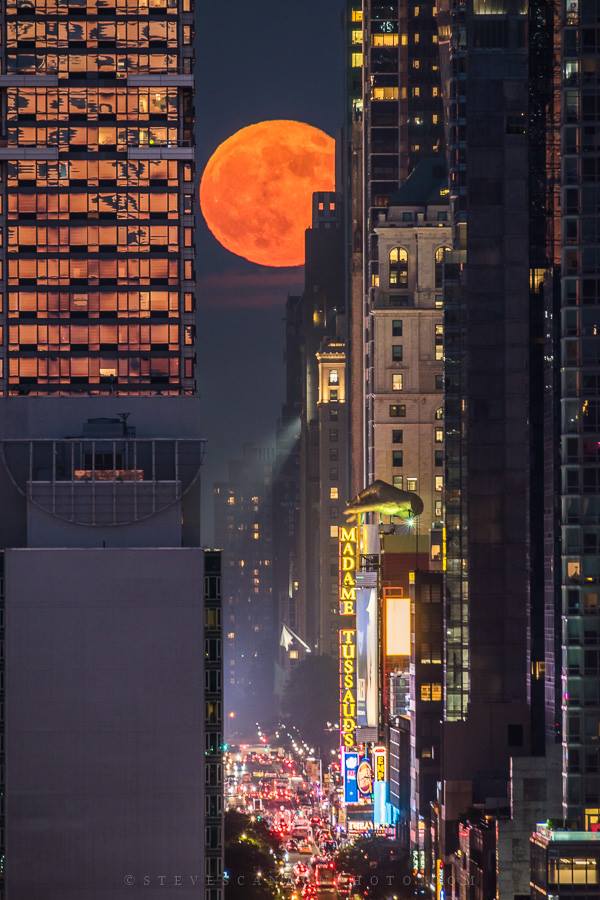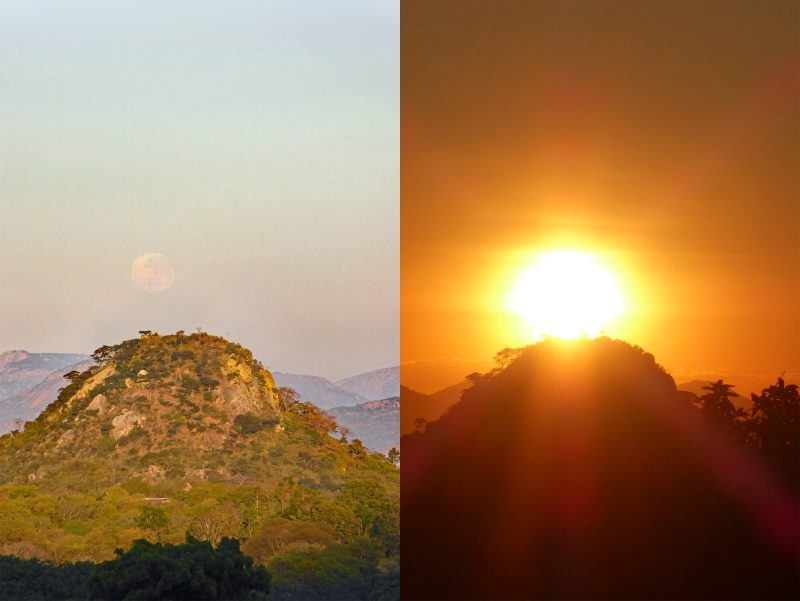
June full moon in an instant
On all of the coming evenings – June 23, 24 and 25, 2021 – the moon might appear full to you. It comes when the moon is most opposite the sun for this month, when its lighted face – its day side – is aimed at us most directly. That full moon instant comes this month on June 24 at 18:39 UTC.
All the full moons have names. In North America, we often call the June full moon the Rose Moon, Flower Moon or Strawberry Moon.
The June solstice – what we in the Northern Hemisphere consider the first day of summer – was just a few days ago. And so, for the Northern Hemisphere, this June full moon presents the first of four summertime full moons. In the Southern Hemisphere, it’s the first of four wintertime full moons.
Some people will call the third of these four seasonal full moons a Blue Moon. We’ll elaborate later in this post.
Full moon from dusk until dawn
Every full moon rises in the east around sunset. It climbs highest up for the night around local midnight (midway between your local sunset and sunrise.). It sets in the west around sunrise. So a moon that’s in the sky all night long is a full moon, or close to being so.
Astronomically speaking, though, the moon is full when it lies opposite the sun in ecliptic longitude (moon-sun elongation = 180 degrees). Again, that’ll be Thursday, June 24, 2021, at 18:39 UTC. For us in the Americas, that means the full moon will be beneath our horizon at the crest of full phase. Translate UTC to your time.
The Americas will see a nearly-full waxing gibbous moon on the night of June 23-24.
Then we’ll see a just-past-full waning gibbous moon on the night of June 24-25.

June full moon mimics December sun
Because a full moon moon stays more or less opposite the sun, the full moon’s nighttime path mimics the sun’s daytime path from six months ago, or six months hence.
This full moon occurs quite close to the June solstice, so this full moon follows near the same path across the sky as the December solstice sun. The December solstice is the Northern Hemisphere’s winter solstice. So the moon’s trek these next few nights will resemble the low path of the winter solstice sun.
North of the Arctic Circle, the wintertime sun never climbs above the horizon. Neither will this June full moon.
Meanwhile – in the Southern Hemisphere – the moon’s flight across the sky will mirror that of the high summer solstice sun.
And, south of the Antarctic Circle, the moon will be out for 24 hours around the clock, simulating the midnight sun of summer.

The story on the upcoming Blue Moon
By season, we’re referring to the period of time between a solstice and an equinox. Or vice versa. And, as mentioned above, we’ve just passed a solstice. So this full moon comes early in the season of northern summer (southern winter). And thus there’s enough time to squeeze four full moons into the current season, which will end at the September equinox on September 22, 2021.
Weirdly, it’s not the fourth of these four full moons that’ll be called a Blue Moon. It’s the third. Go figure. So many will call the full moon of August 22, 2021, a Blue Moon.
Full moons between June 2021 solstice and September 2021 equinox:
June solstice: June 21, 2021
June full moon: June 24, 2021
July full moon: July 24, 2021
August full moon (a Blue Moon): August 22, 2021
September full moon: September 20, 2021September equinox: September 22, 2021
Of course, the third of four full moons in a single season isn’t the only kind of Blue Moon. Popular culture has dictated that the second full moon of a month shall also be called a Blue Moon. Blue Moon is just a name. These moons don’t really appear blue in color. But Blue Moons have an interesting history in modern folklore, which you can read about at the link below:
Read more: What’s a Blue Moon, and when’s the next one?

Blue Moons and the 19-year lunar cycle
You know how we often speak of the many heavenly cycles? Consider the 19-year lunar cycle. That is, every 19 years, the phases of the moon recur on or near the same calendar dates. That’s because 235 lunar months (235 returns to full moon) almost exactly equal 19 calendar years. Sure enough, 19 years from now – in the year 2040 – the full moons will fall on June 24, July 24, August 22, and September 20.
Cool, yes?
Seasonal Blue Moons occur because there are 235 full moons – but only 76 seasons (4 x 19 = 76) – in this 19-year lunar cycle. However, if you have only three full moons in each season, then that’s a total of only 228 full moons (76 x 3 = 228). So we’re missing seven full moons (235 – 228 = 7).
They’re not really missing, of course. They’re the extra seasonal moons we’ve been talking about: the Blue Moons. We list upcoming seasonal Blue Moon dates – after the August 22, 2021 Blue Moon – below:
Seven seasonal Blue Moons in the 19-year lunar cycle:
1) August 19, 2024
2) May 20, 2027
3) August 24, 2029
4) August 21, 2032
5) May 22, 2035
6) May 18, 2038
7) August 22, 2040
Bottom line: The June 2021 full moon comes only a few days after the June solstice. So it’ll closely mimic the path of the December sun. Because this full moon comes so early in the season, we’ll have four full moons between the June solstice and September equinox. Some people will call the third of these four moons a Blue Moon. Thus the next Blue Moon – a seasonal Blue Moon – will come on August 22, 2021.











